Jackie Damrau, Editor
What Customers Crave: How to Create Relevant and Memorable Experiences at Every Touchpoint
by Nicholas J. Webb
Type Tells Tales
by Steven Heller and Gail Anderson
The Routledge Handbook of Metaphor and Language
by Elena Semino and Zsófia Demjén, eds.
Creativity without Law: Challenging the Assumptions of Intellectual Property
by Kate Darling and Aaron Perzanowski, eds.
Fundamentals of Project Management
by Joseph Heagney
Documenting the World: Film, Photography, and the Scientific Record
by Greg Mitman and Kelley Wilder, eds.
Mass Media and Health: Examining Media Impact on Individuals and the Health Environment
by Kim Walsh-Childers
LinkedIn Profile Optimization for Dummies
by Donna Serdula
Current Practices and Trends in Technical and Professional Communication
by Stephen Crabbe, ed.
Communicating Science: A Practical Guide for Engineers and Physical Scientists
by Raymond Boxman and Edith Boxman
Rhetoric of Logos: A Primer for Visual Language
by Eduard Helmann and Brian Switzer, eds.
Secret Sauce: How to Pack Your Messages with Persuasive Punch
by Harry Mills
Introducing Language and Cognition: A Map of the Mind
by Michael Sharwood Smith
How to Success! A Writer’s Guide to Fame & Fortune
by Corinne Caputo
Teaching Interculturally: A Framework for Integrating Disciplinary Knowledge and Intercultural Development
by Amy Lee, with Robert Poch, Mary Katherine O’Brien, and Catherine Solheim
Information Design: Research and Practice
by Alison Black, Paul Luna, Ole Lund, and Sue Walker, eds.
The Zen of Social Media Marketing: An Easier Way to Build Credibility, Generate Buzz, and Increase Revenue
by Shama Hyder
Digital Marketing for Dummies
by Ryan Deiss and Russ Henneberry
Leading Business Change: A Practical Guide for Transforming Your Organization
by Karin Stumpf
Economies of Writing: Revaluations in Rhetoric and Composition
by Bruce Horner, Brice Nordquist, and Susan M. Ryan, eds.
What Customers Crave: How to Create Relevant and Memorable Experiences at Every Touchpoint
Nicholas J. Webb. 2016. New York, NY: AMACOM. [ISBN 978-0-8144-3781-0. 258 pages, including index. US$25.00.]
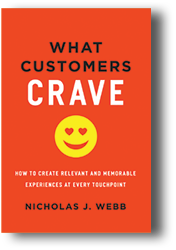 In What Customers Crave: How to Create Relevant and Memorable Experiences at Every Touchpoint, Webb encourages us to rethink customer service by exchanging the word “service” for “experience.” He says, “In today’s hyper-connected, hypercompetitive business world, old ways of providing customer service are failing” (p. 1). We must reassess what we think we know about customers to breathe life back into the customer experience.
In What Customers Crave: How to Create Relevant and Memorable Experiences at Every Touchpoint, Webb encourages us to rethink customer service by exchanging the word “service” for “experience.” He says, “In today’s hyper-connected, hypercompetitive business world, old ways of providing customer service are failing” (p. 1). We must reassess what we think we know about customers to breathe life back into the customer experience.
Two questions are at the core of Webb’s strategy: What do customers love? What do they hate? To find out, we must identify our customer types and use this knowledge to invent relevant customer experiences. According to Webb, customer typing “helps you move from what your customers are to who they are” (p. 28). And when we know what our customers love and hate, we begin to truly understand who they are. Today, we can gather limitless amounts of customer data through digital means such as social media and e-commerce. But Webb reminds us to also meet in the “non-digital” world and physically experience what our customers experience.
In the second half of What Customers Crave, Webb describes five customer experience touchpoints and insists that exceptional experiences must be delivered at all five points. The “pre-touchpoint” occurs before customers decide to engage with a product or service. The “first touchpoint” is the first impression like the greeter at a store or a Web site’s landing page. The “core touchpoint,” when customers actively engage with a product or service, can be problematic for organizations if they “transform from being customer-centric to operations-centric” (p. 167). The “last touchpoint,” when delivered effectively, establishes a memorable experience that keeps customers wanting more. The “in-touchpoint,” driven largely by content marketing, can nurture “existing and past customers by sending them a constant stream of value” (p. 203).
Knowing our customers empowers us to innovate and invent—but Webb says we should strive to “disrupt” the customer experience, not merely enhance it. In his words, “The problem occurs when we look at innovation to create new profit centers rather than to deliver better human experiences” (p. 59).
So, what can technical communicators take away from the customer experience discussion? Upon finishing Webb’s book, I was reminded of the following: Content, no matter what the subject or purpose is, can be exceptional. It can be innovative in a disruptive way. Great content builds customer loyalty and promotes brand advocacy, which in turn drives sales. In today’s competitive landscape, our roles are changing and the call to innovate is no less imperative for us than for any sales or marketing team. Companies “touch” their customers at many different points, and technical communication can be an integral part of any touchpoint. In Webb’s words: “Remember, whether you’re selling a product or a service, you are in the customer experience business” (p. 116).
Amy Dunbar
Amy Dunbar is an STC member and a technical writer for Pearson VUE in Bloomington, MN. She has a degree in biology and a graduate certificate in technical communication from the University of Minnesota. Amy’s professional interests include content marketing, video production, and information design.
Type Tells Tales
Steven Heller and Gail Anderson. 2017. New Haven, CT: Yale University Press. [ISBN 978-0-300-22679-9. 224 pages, including index. US$45.00 (softcover).]
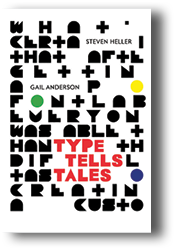 Type Tells Tales is an artful exploration of the boundaries of type. This lavishly illustrated, full-color tome is a pleasure to thumb through, and its generous size (9½ × 13½”) makes it a suitable addition to your home coffee table or office waiting area. If curling up on the couch and thumbing through contemporary examples of innovative typographic design sounds like a good way to spend an afternoon (really, what could be better?), then Type Tells Tales won’t disappoint you.
Type Tells Tales is an artful exploration of the boundaries of type. This lavishly illustrated, full-color tome is a pleasure to thumb through, and its generous size (9½ × 13½”) makes it a suitable addition to your home coffee table or office waiting area. If curling up on the couch and thumbing through contemporary examples of innovative typographic design sounds like a good way to spend an afternoon (really, what could be better?), then Type Tells Tales won’t disappoint you.
Not only is the book gorgeously illustrated, but the writing is richly appointed with adjectives, so that it paints a vivid tapestry of the lives and techniques of the various graphic designers and typographers featured. Turn to any page, and you are instantly transported to the time and place in which each designer pushed the boundaries of his or her craft.
Heller and Anderson do not set out to showcase pristine, unobtrusive typography. Nor do they set out to prescribe best practices in type selection or layout. Instead, they strive to celebrate the “well-meaning heretics” who have challenged traditional principles of typography and media and have sought to innovate and disrupt. Heller and Anderson contend that type is content and that “type and letters are not passive, but are active participants in an entire composition” (p. 15). Typography’s symbiotic influence with architecture is often cited in typography books as a way of understanding the different styles of type, but Type Tells Tales asserts that at least since the late 19th century, typography has spurred social, technological, and political upheavals in Western nations.
The book is organized in such a fashion that you can jump in and out without having to read sequentially. Each profile is a snapshot of a designer and his or her work. This allows you to flip through and stop when something catches your eye. This makes finding inspiration and contextualizing design an easy process. The profiles not only discuss the lives of the artists, but also explain their processes. The artists represented span the early 20th century to present day, from a variety of countries around the world. On one page, you can read about how a designer was slain by the SS (Schutzstaffel) during World War II, and on another you can learn about how a designer developed a beautiful wedding suit lining that depicted typeset online chats with his bride-to-be. The variety of artists, design styles, and media profiled in 219 pages is breathtaking.
While Type Tells Tales ostensibly promotes pushing the boundaries of type by shaping it to fit the unique situation, the type set by the authors represents a pretty staid template. The table of contents and chapter pages seem to be the only areas the authors took risks with their own type. This seems to indicate that the form of type must still follow the function of reading.
Michael Opsteegh
Michael Opsteegh is an STC Senior Member and a technical writer in the software and financial services industries since 2004. He is a lecturer in the technical communication program at Cal State Long Beach. Michael holds a master’s degree in English and is a Certified Technical Professional Communicator (CPTC).
The Routledge Handbook of Metaphor and Language
Elena Semino and Zsófia Demjén, eds. 2017. New York, NY: Routledge. [ISBN 978-1-138-77536-7. 542 pages, including index. US$240.00.]
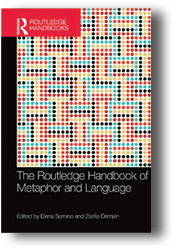 The Routledge Handbook of Metaphor and Language collects 34 essays that examine how metaphor works in language. The background theory that the authors use is one developed by Lakeoff and Johnson as well as Gibbs and theorizes about how metaphor and language interact at a cognitive level.
The Routledge Handbook of Metaphor and Language collects 34 essays that examine how metaphor works in language. The background theory that the authors use is one developed by Lakeoff and Johnson as well as Gibbs and theorizes about how metaphor and language interact at a cognitive level.
While all 34 essays contain insights for those interested in metaphor and language, a group of essays in Part V address more specific subjects. Applications of metaphors in health screening (chapters 25 and 26), business (27), education (28), and public communication of complex issues (30) offer technical communicators some familiar contexts.
Other essays that technical communicators could find interesting and useful include those on translation (17), climate change (20), politics (21), advertising (22), and online communication (24). The citations do not always intrude, interrupting the flow of the content, yet they do slow reading. But, that is the way of scholarly and academic writing.
One question technical communicators could have is why do we need metaphor to communicate? Historically, text that includes a heavy use of metaphor has been often described as “flowery” and writers should avoid it. Research, such as is contained in this Handbook, especially that tying metaphor to cognition, points out that language’s effectiveness is diminished when devoid of metaphors.
Conceptual Metaphor Theory isn’t the only theory of metaphor discussed such as Aristotelian approaches to metaphor (14, 21, 22, and 32), metaphor-led discourse analysis (6, 29), dynamics systems theory (4), and different types of theory useful for different types of metaphor.
While most readers will understand a bit of the relationship between metaphor and oral and written language, one chapter (18) looks at metaphor in sign language—an area many might overlook when studying metaphor, language, and cognition. Other areas one might not think of when studying metaphor include metaphor and gesture studies, historical linguistics, language acquisition, second language teaching and learning, politeness/impoliteness, and empathy. In short, The Routledge Handbook of Metaphor and Language covers a broad range of specialties and covers much more than these areas. For example, several essays discuss metaphor in languages other than English and would prove valuable for technical communicators who translate and localize information.
In summing up their overview of the book, the editors comment that “one theme emerges again and again: the ability of metaphors to ‘frame’ topics and ideas in particular ways” (p. 9).
For technical communicators who have an interest in language and how it works, this Handbook would be a valuable asset. For technical communicators looking to improve the quality of their information, the handbook would also be a valuable asset. While the price may stop many from acquiring a personal copy, it certainly should be in a company library. Students, in technical communication classes and other language classes, as well as their faculty, will also find value in the Handbook.
Tom Warren
Tom Warren is an STC Fellow, Jay R. Gould Award for Excellence recipient, and professor emeritus of English (technical writing) at Oklahoma State University, where he established the BA, MA, and PhD technical writing programs. Past president of INTECOM, he served as guest professor at the University of Paderborn, Germany.
Creativity without Law: Challenging the Assumptions of Intellectual Property
Kate Darling and Aaron Perzanowski, eds. 2017. New York: New York University Press. [ISBN 978-1-4798-5624-4. 280 pages, including index. US$30.00 (softcover).]
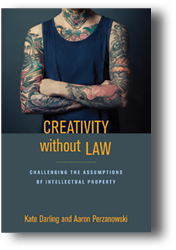 Intellectual property theory rests on a dominant narrative, a set of assumptions about how creative ecosystems work, the motivations and incentives that drive creativity, and the role that law should play in spurring innovation. Central to that narrative is the assumption that legal protection against copying through “rights exclusion”—copyright and patents—is necessary for creative behavior to occur.
Intellectual property theory rests on a dominant narrative, a set of assumptions about how creative ecosystems work, the motivations and incentives that drive creativity, and the role that law should play in spurring innovation. Central to that narrative is the assumption that legal protection against copying through “rights exclusion”—copyright and patents—is necessary for creative behavior to occur.
While the dominant narrative is logical and has powerful advocates, it is not without problems. The legal-centric, “right exclusion,” approach is complex, expensive, and subject to abuse.
The editors of Creativity without Law: Challenging the Assumption of Intellectual Property argue that the role of “rights exclusion” in promoting creativity has been subjected to “surprisingly little scrutiny” (p. 1), and that this lack of scrutiny has produced a legal-centric IP system that displays “a troubling insensitivity to the specific needs of particular creative communities” (p. 2).
While conceding that there are important areas that closely fit the dominant narrative—movie production, pharmaceutical research—Creativity without Law makes its case by looking at counter examples.
In a series of fascinating studies by various authors, the book investigates the dynamics of creative activities and subcultures that manage to thrive without the protection of law, either because the law does not reach the activity, or because the community involved would rather regulate itself. Among the creative subcultures investigated are French chefs and recipe creation, designer cocktails creation, medical procedure innovation, tattooing, street art and graffiti, Roller Derby, adult entertainment (pornography), fan fiction, and Nigerian movie production.
While the specifics vary tremendously, each of the examined creative communities functioned differently from what the dominant narrative would have predicted. For example, in many communities, reputation and social esteem proved to be stronger incentives for creativity than financial gain. Also, each community showed a remarkable capacity for self-regulation, primarily through the development of behavioral norms to govern such things as the conditions under which sharing and copying can occur. Often, social pressures ranging from bad-mouthing to ostracism were used to discipline those who violated norms. In short, in the absence of legal protections, each had worked out unique systems of norms for policing themselves and providing the right balance of incentives and controls to allow the creative community to thrive.
They also showed flexibility in other ways. Some found that a certain amount of copying and imitation was beneficial because it established trends and fueled demand, while others adjusted their business model to take the prevalence of copying into account.
If our goal is to maximize innovation and creativity, it behooves us to know as much as possible about how creative communities operate and regulate themselves “on the ground.” The studies in Creativity without Law go a long way toward calling long-held assumptions into question, and provide a good starting point for further investigation.
Patrick Lufkin
Patrick Lufkin is an STC Fellow with experience in computer documentation, newsletter production, and public relations. He reads widely in science, history, and current affairs, as well as on writing and editing. He chairs the Gordon Scholarship for technical communication and co-chairs the Northern California technical communication competition.
Fundamentals of Project Management
Joseph Heagney. 2016. 5th ed. New York, NY: AMACOM. [ISBN 978-0-8144-3736-0. 228 pages, including index. USD$17.95 (softcover).]
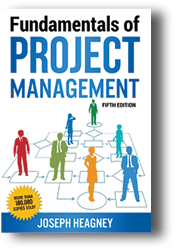 Currently serving as a faculty member of the American Management Associate, author Joseph Heagney previously served as the global leader for project management best practices for the same group. With Fundamentals of Project Management in an impressive fifth edition, Heagney must be doing something right as he continues to have impressive sales of the series. In this edition, he covers topics related to the latest version of the Project Management Body of Knowledge (PMBOK® Guide) and the project management basics.
Currently serving as a faculty member of the American Management Associate, author Joseph Heagney previously served as the global leader for project management best practices for the same group. With Fundamentals of Project Management in an impressive fifth edition, Heagney must be doing something right as he continues to have impressive sales of the series. In this edition, he covers topics related to the latest version of the Project Management Body of Knowledge (PMBOK® Guide) and the project management basics.
Stakeholder management, creating a communication plan, estimating, and project closure appear as new topics in Fundamentals of Project Management. Heagney argues that the goal of effective project management today remains to execute a project on time, within budget, and within scope. What changed includes approaches and techniques to achieve that goal.
What percentage of projects currently succeed in meeting their goals of being on time and within budget? Heagney addresses this when he notes that the percentage remains “flat at 64 percent between 2012 and 2015” (p. xi). This is according to the “Pulse of the Profession” report published by the Project Management Institute. Heagney goes on to note that high performing organizations today “drive project management and meet original project goals and business intent two-and-a-half times more often” (p. xi) when compared to low performers.
Heagney defines stakeholders as “anyone who has a vested interest…in the outcome of the project” and notes that they have a “direct effect on whether your project will succeed or fail” and should be “managed throughout the life of the project” (p. 47). He gives tips on how to deal with stakeholders in the context of cultural factors and how best to communicate.
Overall, for project managers today to stay effective they must adjust for factors such as “technological advances, workplace demographics, [and] global reach” (p. xii). That is how Heagney sees it as he asks you to “learn from the past—and look to the future” (p. xii). That sounds like great advice.
One of the exercises (p. 45) in the current edition of Fundamentals of Project Management is for you to answer the question, “Which must be decided first for effective project management planning?”
- Strategy
- Tactics
- Logistics
- Does not matter
You should enjoy reading the book to get the answer Heagney provides.
Jeanette Evans
Jeanette Evans is an STC Associate Fellow and active in the NEO community. She holds an MS in technical communication management from Mercer University. Jeanette is co-author of an STC Intercom column on emerging technologies in education and writes on other topics related to project management.
Documenting the World: Film, Photography, and the Scientific Record
Greg Mitman and Kelley Wilder, eds. 2016. Chicago, IL: University of Chicago Press. [ISBN 978-0-226-12911-2. 285 pages, including index. US$35.00.]
 What does photography––still or motion––contribute to our picture, our image, our understanding of historical events and the world in general? Mitman and Wilder attempt to answer this question in Documenting the World: Film, Photography, and the Scientific Record. And in many ways, the book’s contributors have done a superb job answering the editors’ question.
What does photography––still or motion––contribute to our picture, our image, our understanding of historical events and the world in general? Mitman and Wilder attempt to answer this question in Documenting the World: Film, Photography, and the Scientific Record. And in many ways, the book’s contributors have done a superb job answering the editors’ question.
“Documentary images matter in the way that people imagine the past, make sense of the present, and envision the future” (p. 4). When we think of seminal events like the Great Depression, Auschwitz, the Apollo moon landing, or Kennedy’s assassination—what role does film play, compared to reading about them?
The Depression is a prime example: What would Americans’ sense of the Great Depression be, without those images captured on film and stills; images of sharecroppers, migrant workers, and the urban poor? How many people still read the great fictional exposés by Sinclair Lewis and Frank Norris? Still, in the 21st century, with its ever-present stress on visual culture, such events may seem vague, hollow, imprecise—even unscientific without the visual image.
When considering the deeper effects of print versus film, the book skips one important question: To what extent does one complement or replace the other? In some ways, visuals capture more details than print. In other ways, words can go into details that visuals cannot–-specifically, with more abstract concepts that are not captured in “natural” photography.
What are some fields photography has had a major impact on? They include visual anthropology and art history, besides documenting great historical events where possible. Other areas of impact include images for the travel industry, the role of visuals as evidence in the legal system, and in almost every area of science.
Photos and film can still be so easily “repurposed.” The visual record is anything but neutral. Think of the role of film for propaganda; a prime example being Leni Riefenstahl’s “Triumph of the Will;” Hitler’s coming out party for the new Aryan Race, in the 1936 Berlin Olympics.
As for the effect of photography on people’s thinking, Documenting the World points out that the introduction of the still camera in 1838 developed ordinary people’s (nonscientists) powers of observation; churning out “observers of very high quality” and resulting in what one scholar referred to as “the cult of observation” (p. 12). “The camera elevated the everyday to the status of scientific objects across the…human and life sciences” (p. 12), and in this way, provided what another specialist termed “a new medium of seeing” (p. 13).
As technical communicators, we tend to limit our use of visuals to non-photographic images such as charts, graphs, and diagrams. But there are places where film—stills or motion—are the best way to communicate the information. And it’s in those places where we need to consider these elements in our project. Documenting the World helps develop our sensitivity to photographic media.
Tetyana Darian
Tetyana Darian is an STC member and graduate student in mathematics. Her interests are in graph theory and its applications. Tetyana is also a part-time lecturer, teaching introductory mathematics courses.
Mass Media and Health: Examining Media Impact on Individuals and the Health Environment
Kim Walsh-Childers. 2017. New York, NY: Routledge. [ISBN 978-1-138-92560-1. 520 pages, including index. USD$44.95 (softcover).]
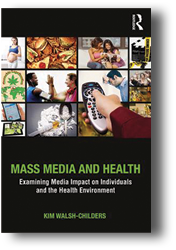 Mass Media and Health: Examining Media Impact on Individuals and the Health Environment reviews numerous studies on various aspects of mass media’s influence on both individual health behaviors and health policy. It grew out of its author’s teaching activities. Despite its scholarly character, each chapter opens with a personal story of media consumption related to the health issue covered in that chapter. However, each chapter also includes an extensive list of references. The heavy use of statistics and meticulous annotation of all facts and figures cited make the book quite useful for students and others in academia. On the other hand, these features also make it less-than-ideal bedtime reading for the casual reader.
Mass Media and Health: Examining Media Impact on Individuals and the Health Environment reviews numerous studies on various aspects of mass media’s influence on both individual health behaviors and health policy. It grew out of its author’s teaching activities. Despite its scholarly character, each chapter opens with a personal story of media consumption related to the health issue covered in that chapter. However, each chapter also includes an extensive list of references. The heavy use of statistics and meticulous annotation of all facts and figures cited make the book quite useful for students and others in academia. On the other hand, these features also make it less-than-ideal bedtime reading for the casual reader.
Walsh-Childers discusses tobacco, alcohol and consumer-focused medication advertising, and the effects of media portrayals on food consumption, body image, sexual health, violent behavior, and use of street drugs, among other issues. The section on policy effects is much smaller than that on individual behavior and covers the effect of health news, media advocacy, and issue advertising on political decision-making. A separate chapter discusses the influence of social media posts, blogs, and other more personal forms of online media on people’s health-related decisions.
Perhaps because of when studies on specific topics were conducted, the timeframe for the statistics cited varies widely, with some as old as the late 1990s. Given the rapid change in media technology and the uneven distribution of that technology across demographic groups, it is difficult to draw conclusions over time. The relatively long publishing cycle for print publications may also make the more current statistics in Mass Media and Health outdated before an updated edition is available to the public. Walsh-Childers acknowledges this problem, for example, when discussing violent video games, which were last comprehensively analyzed before 2005. Gaming content and graphics—such as the quite realistic imagery and 360-degree views of current first-person shooters—have changed drastically since then.
The book provides an overview of the various issues, so research delving into demographic differences in media use and health behaviors may lay outside its scope. However, such studies could prove illuminating. For example, one study cited found that “more time spent reading health magazines predicted a lower likelihood of smoking” (p. 370). It would be interesting to examine the characteristics of such magazines’ readership before that study.
Overall, the large number of references makes Mass Media and Health a useful tool for journalists and others writing on the topics it covers. The book’s structure and use of statistics also serves media studies or medical communications teachers, who may want to assign it as a textbook.
Barbara Jungwirth
Barbara Jungwirth writes about medical topics (www.bjungwirth.com) and translates medical and technical documents from German into English (www.reliable-translations.com). She has written for print and online media since her high school days and majored in media studies. You can find her on Twitter at @reliabletran.
LinkedIn Profile Optimization for Dummies
Donna Serdula. 2017. Hoboken, NJ: John Wiley & Sons, Inc. [ISBN 978-1-119-28708-7. 324 pages, including index. US$26.99 (softcover).]
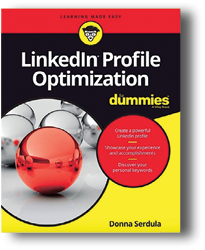 If you have recently attended a networking event and swapped contact information with your new contact, the odds are that at least one of your contacts has sent you an invitation to connect on LinkedIn, a professional networking site. While LinkedIn is free to join and makes it easy to create a personal profile, most people do not take the time to learn the nuances of crafting an effectively presented LinkedIn profile. How much detail do you add? Is it worth including a photo? How similar to my résumé should it be? What do I place in my profile summary? These are all questions that LinkedIn Profile Optimization for Dummies adroitly handles.
If you have recently attended a networking event and swapped contact information with your new contact, the odds are that at least one of your contacts has sent you an invitation to connect on LinkedIn, a professional networking site. While LinkedIn is free to join and makes it easy to create a personal profile, most people do not take the time to learn the nuances of crafting an effectively presented LinkedIn profile. How much detail do you add? Is it worth including a photo? How similar to my résumé should it be? What do I place in my profile summary? These are all questions that LinkedIn Profile Optimization for Dummies adroitly handles.
Much like other books published under the “For Dummies” series, this book strives to simplify a sophisticated concept, in this case, LinkedIn. Serdula divides the book into several sections, such as “Getting Your LinkedIn Profile Started,” and even recommends which sections to pay extra attention to if you’re short on time. The chapters within each section clearly build on one another and help guide both new and experienced users. New LinkedIn users will find step-by-step instructions to walk you through both simple and complex tasks alike. For seasoned users, Serdula delves into the deeper regions of LinkedIn, such as groups, influencers, and personal branding. People of all experience levels can benefit from her lists of keywords that help flesh out your descriptions in a professional but eye-grabbing manner. The books doubles as a workbook, so if you are creating your profile while reading straight through the book, each section builds on the previous content you added to LinkedIn. Its generous illustrations, clear instructions, and logical organization create a sound paper-based experience for upgrading your electronic persona.
Even if you consider yourself an expert in social networking, LinkedIn Profile Optimization for Dummies has something for you. Perhaps your personal summary is not up to par, your email address not trendy enough (avoid AOL or Hotmail or else be screened as a technical dinosaur, warns Serdula), or maybe your professional photo doesn’t do you justice. Throughout the book, Serdula uses her own LinkedIn profile as an example so you can see exactly how she puts her recommendations into practice. Overall, I see LinkedIn Profile Optimization for Dummies as an excellent resource to help you bridge the gap between traditional résumés and new online professional networking.
Timothy Esposito
Timothy Esposito is an STC Associate Fellow with over 15 years of technical communication experience. He is currently president of the STC Philadelphia Metro Chapter. Before becoming president, Timothy was chapter vice president, treasurer, webmaster, and scholarship manager.
Current Practices and Trends in Technical and Professional Communication
Stephen Crabbe, ed. 2017. Croydon, U.K.: Institute of Scientific and Technical Communicators. [ISBN 978-0-9506459-9-5. 350 pages, including index. USD$44.50 (softcover).]
 Several years ago, STC had a publications group that published printed materials for practitioners and students. Topics ranged from glossaries and estimating illustration costs, to writing proposals, basic articles for the beginners, and much more. Costs and the digital age led to the program’s demise.
Several years ago, STC had a publications group that published printed materials for practitioners and students. Topics ranged from glossaries and estimating illustration costs, to writing proposals, basic articles for the beginners, and much more. Costs and the digital age led to the program’s demise.
In Europe, national technical societies also provide education for their members. For example, in the UK in 2001, the Institute of Scientific and Technical Communicators (ISTC) published an anthology entitled Technical Communication and Information Design. This year, they have published a new anthology, Current Practices and Trends in Technical and Professional Communication. In 16 chapters divided into three parts, authors explore writing technical communications (6 chapters), resources for technical communicators (5), and the role of technical communicators (5).
The anthology’s primary readership in both the US and UK not only includes practicing technical communicators, but also students, technical communication teachers, and program directors. In the US, teachers and directors can find not only current practices in the UK that are mirrored in the US, but the research behind them. That alone makes Current Practices and Trends valuable, deserving a major role in professional development.
The anthology’s authors are about evenly divided between academics and non-academics. One major difference from similar anthologies is that the academics are also practicing technical communicators as well as teachers. They, therefore, know not only content and how work progresses, but also know how to present it for learning.
An excellent example of an essay applicable to all technical communication programs and practitioners is the chapter on style (Chapter 3). What style should students learn and use? What style should technical communicators practice? Edwards makes a strong case for a personalized style—there being, in his opinion, no such thing as a “neutral” style.
Two chapters discuss applying theory to technical communication: Chapter 8 uses systems thinking for complex documents, and Chapter 14 applies risk management to document reviewing.
The last essay (16) discusses the possibility of computer-based Artificial Intelligence (AI) writers working on teams with human technical communicators. Lawrence and Green base their assessment of AI writers on the STC Body of Knowledge. They argue that an AI writer can contribute to Technical Writer Level I positions as well as being useful for Levels II and III. As you read this essay, you begin to wonder if the chapter itself were written by an AI writer because of the style and vocabulary. I think at least some of this chapter was written by an AI writer, but you will have to read it yourself and judge.
For US students, teachers, and program directors, as well as practicing technical communicators in both countries, this anthology offers considerable value for money. While it has some elements that are unique to the UK, most of the material is equally applicable to the US.
Tom Warren
Tom Warren is an STC Fellow, Jay R. Gould Award for Excellence recipient, and professor emeritus of English (technical writing) at Oklahoma State University, where he established the BA, MA, and PhD technical writing programs. He is a Horace Hockley Award winner as well as past president of INTECOM and served as guest professor at the University of Paderborn, Germany.
Communicating Science: A Practical Guide for Engineers and Physical Scientists
Raymond Boxman and Edith Boxman. 2017. Hackensack, NJ: World Scientific Publishing. [ISBN 978-981-3144-23-1. 276 pages, including index. USD$32.00 (softcover).]
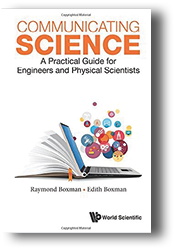 The importance of effective scientific communication cannot be underestimated. With numerous books on the subject, I wondered what made Communicating Science: A Practical Guide for Engineers and Physical Scientists different from the others. Three aspects stand out: It covers relevant genres for its researcher and graduate student audience, includes abundant and helpful examples, and offers effective writing strategies.
The importance of effective scientific communication cannot be underestimated. With numerous books on the subject, I wondered what made Communicating Science: A Practical Guide for Engineers and Physical Scientists different from the others. Three aspects stand out: It covers relevant genres for its researcher and graduate student audience, includes abundant and helpful examples, and offers effective writing strategies.
The introduction, however, gives readers a false sense of what follows in subsequent chapters. The perspective portrayed in the opening comes across as limiting, portraying scientific writing through the stereotypical lens of being a mode of transmission, promising “recipes” (p. 3) for writing, and even includes the clichéd statement: “Scientific writing uses limited vocabulary and grammatical forms, it is conventional and the emphasis is on clarity and not on linguistic gymnastics” (p. 4). Fortunately, this perspective does not manifest in the rest of the book.
Communicating Science first addresses technical reports and scholarly articles since engineers and scientist spend much of their time writing to other technical personnel. The authors thoroughly explain and provide examples of the prewriting activities, such as developing solid research questions, understanding audience, and planning. Even though the content of reports and scholarly papers vary depending on companies and journals, these sections are discussed in detail and supported with numerous examples using topics on engineering and physical science. Emphasis is placed on the critical aspects of these sections, such as the first sentence in the introduction, identifying a gap in research, and the purpose statement. The methods, results, discussion, and conclusion sections are broken down into subsections that many engineers and physical scientists will find relevant to their work, including creating effective, ethical figures and tables. The examples in each chapter are especially impressive. There is an explanation about how to write a particular document section, a table of examples usually follows, and within the table the authors explain the examples as meeting or not meeting the previously discussed criteria.
Subsequent chapters address genres used for non-technical and general audiences, such as conference presentations, proposals, business plans, patents, popular media, and correspondence for job searches. Of importance is how one communicates with technical audiences and the public as they have quite different interests. Public audiences are “particularly interested in the human aspects” (p. 156) of engineering and scientific projects. They want to know how those projects or the science “affect[s] them personally, or at least how they may affect other people or even humanity” (p. 156). Pointing out the different interests helps scientists communicate their research in more compelling ways that allow people to understand their work and care about it too.
Communicating Science has definite value for students and practicing scientists, even experienced practitioners. Science is very much a part of the public domain today. It is critical that scientists know how to convey ideas clearly and coherently to various audiences, which this book covers quite well.
Diane Martinez
Diane Martinez is an assistant professor of professional and technical communication at Western Carolina University. She previously worked as a technical writer in engineering, an online writing instructor, and an online writing center specialist. She has been with STC since 2005.
Rhetoric of Logos: A Primer for Visual Language
Eduard Helmann and Brian Switzer, eds. 2016. New York, NY: Niggli. [ISBN 978-3-7212-0957-0. 144 pages, including index. US$29.95 (softcover)E.]
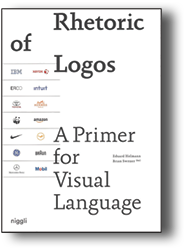 In the Rhetoric of Logos: A Primer for Visual Language, Helmann and Switzer explore logo design through the lens of classical rhetoric, applying the appropriate theories and translating them to design for visual communication. The editors state that a goal for the work is to find a more scientific, less objective approach to evaluating the effectiveness of logo designs of which Helmann’s ideas are intriguing to say the least. Broken up into three sections, the book starts out a bit slow, with a section on history of logo design, but picks up as it nears the content’s heart, the analysis of rhetoric devices found in logos.
In the Rhetoric of Logos: A Primer for Visual Language, Helmann and Switzer explore logo design through the lens of classical rhetoric, applying the appropriate theories and translating them to design for visual communication. The editors state that a goal for the work is to find a more scientific, less objective approach to evaluating the effectiveness of logo designs of which Helmann’s ideas are intriguing to say the least. Broken up into three sections, the book starts out a bit slow, with a section on history of logo design, but picks up as it nears the content’s heart, the analysis of rhetoric devices found in logos.
The history section, “In the beginning was the brandmark”, is overly simplified in such a way that you begin to wonder why it was included at all, especially the very narrow timeline the editors chose to include. Regardless of this issue, the section does include interesting details about the history and use of heralds by knights as well as coats of arms used by guilds that are not often included in history texts, despite the distinct connection to the development of logos and eventually brand design. Rhetoric of Logos starts to pick up at the end of the section, in “Five elements”; however, it would have been beneficial if the editors had spent more time here as well. The terms and definitions in this section are not as clear as they could be, a problem that seemed to be an issue throughout the text.
The next section includes an analysis of logos using classical devices of rhetoric, including a brief description of each device and examples of (mostly) well-known logos for each. While this breakdown is fascinating, it seems that a little more information on how the examples fit each of the devices is warranted so that readers can apply this logic to their own logo design evaluation.
The final section is a bit hard to define. Although it seems that it might provide the methods for evaluating logos using persuasional methods of rhetoric, including logos, ethos, and pathos, there is not much detail provided on how the editors go about the evaluation, making it difficult once again for readers to replicate. This section, as in the previous, would benefit from a well-defined tool.
One main weakness of this book is that the editors assume a lot of knowledge from the reader; the work would benefit from more in-depth explanations. The text has much to offer regarding value and insight but needs to be revised to appeal to a broader audience of graphic designers and design students. In its current state, Rhetoric of Logos reads as an abbreviated master’s thesis study and seems a little too formal in its approach for the average reader. This book will appeal mostly to academics and extreme branding enthusiasts; however, a more thorough account would be largely beneficial to students of logo and brand design. This seems to be an early work on the subject and one in which this reviewer looks forward to seeing where this study progresses.
Amanda Horton
Amanda Horton holds an MFA in Design and currently teaches graduate and undergraduate courses at the University of Central Oklahoma (UCO) in the areas of design technology, design studio, and history of graphic design. Ms. Horton is also the director of the Design History Minor at UCO.
Secret Sauce: How to Pack Your Messages with Persuasive Punch
Harry Mills. 2017. New York, NY: AMACOM. [ISBN 978-0-8144-3806-0. 184 pages. US$18.95.]
 In Secret Sauce: How to Pack Your Messages with Persuasive Punch, the overall premise is a practical formulaic system that will help you communicate influentially in today’s digital environment. After an introduction of Mills’ argument that viewers are increasingly becoming desensitized and harder to reach because of an information surplus, he walks you through a step-by-step process known as the SAUCE (Simple, Appealing, Unexpected, Credible, and Emotional) method and how to achieve it.
In Secret Sauce: How to Pack Your Messages with Persuasive Punch, the overall premise is a practical formulaic system that will help you communicate influentially in today’s digital environment. After an introduction of Mills’ argument that viewers are increasingly becoming desensitized and harder to reach because of an information surplus, he walks you through a step-by-step process known as the SAUCE (Simple, Appealing, Unexpected, Credible, and Emotional) method and how to achieve it.
The first half of the book provides a thorough, yet concise, exploration focusing on each letter of SAUCE: Simple–stick to one thing; Appealing–personalized to be relevant; Unexpected–the element of surprise; Credible–be honest; Emotional–make it relatable. Each of these chapters concludes with a 3-question test that will help you determine the persuasiveness of a message within that category (letter). This score is later plugged into the “heat gauge” to show how effective the message is overall.
In the second half, Mills presents lessons that reference case studies, experiments, and analysis of branding failures and triumphs. From J.C. Penney to slot machines to documentaries to littering, Mills uses academic worthy citations of psychological and scientific data while maintaining a casual tone throughout proving his theory—it matters how you craft a message. Illustrated charts, lists, and diagrams scatter throughout the pages and is another way that Mills uses his own method—creating the unexpected with stylistically playful graphics that break up the content making it easy to get through.
Secret Sauce is a compact book in dimension and page count and plays out like a pocket guide/workbook for knowing how to communicate messages effectively, so they receive the attention they deserve. This book is a good option for researchers, writers, and those in the creative industry.
Lanie Gabbard
Delana (Lanie) Gabbard is an associate professor of graphic design with a specialty in typography at the University of Central Oklahoma after several years of working professionally as a graphic designer. She is an award-winning designer and has been published academically and online.
Introducing Language and Cognition: A Map of the Mind
Michael Sharwood Smith. 2017. Cambridge, U.K.: Cambridge University Press. [ISBN 978-1-316-60670-4. 224 pages, including index. USD$29.99 (softcover).]
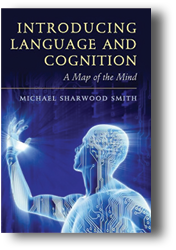 A major question that has long puzzled philosophers and scientists is, “What is the mind?” Once that is answered, then many other questions suggest themselves such as, “How is the mind related to, among other things, the brain and consciousness?” Attempts to answer narrower questions follow: “Is mind the same as soul?” “How does language relate to mind, brain, consciousness, soul, and so forth?” Sharwood Smith’s Introducing Language and Cognition: A Map of the Mind attempts to answer several of these questions.
A major question that has long puzzled philosophers and scientists is, “What is the mind?” Once that is answered, then many other questions suggest themselves such as, “How is the mind related to, among other things, the brain and consciousness?” Attempts to answer narrower questions follow: “Is mind the same as soul?” “How does language relate to mind, brain, consciousness, soul, and so forth?” Sharwood Smith’s Introducing Language and Cognition: A Map of the Mind attempts to answer several of these questions.
He begins with an “Introduction” and ends with a “Conclusion;” both with an overview and summary. The chapters open with “In This Chapter” and close with a “Summary.” Other aides for the reader include an annotated abbreviation list, glossary, and references.
He divides his subject into two parts: Part I addresses the “Mechanisms of the Mind” (eight chapters) and Part II addresses “Language(s) in the Mind” (seven chapters). In a lengthy Introduction, Sharwood Smith suggests that mind is composed of modules, corresponding roughly to the senses. Each module is part of what he calls a “framework” and has a processor and memory store. Chapter 1 explains the basic design, and chapters 2 and 3 cover perception and motion. He explains meaning (4); emotions (5); memory, processing, and activation (6); consciousness and attention (7); and developing knowledge and ability (8). Collectively, these chapters introduce the reader to his framework or map of the mind that he later calls a “mind-web.”
Part II presents his views on how language will work in the mind. Language, he argues in chapter 10, consists of phonological and syntactic structures and is called “the core system.” He then looks beyond this core to structures outside the core: sounds, meanings, and language. His point is that we experience a world that we think is an external context forgetting that what we experience is a re-creation of the outside context by the inside context.
Because his assumed readers are researchers beginning to do research in language and the mind, the typical technical communicator will have problems with this book. However, those who want to understand more thoroughly the user of technical documents will find much to think about. Graduate students in technical communication who are considering how users respond will also find much to think about, and those taking communication theory seminars as well as faculty working or teaching in this area will also gain the most from Sharwood Smith’s theory.
What’s the point for technical communicators? How do they improve their technical communication? Because a module receives language input, does the user have appropriate structures to process it? If so, then processing occurs. If not, then the receiving module must develop a structure or structures before continuing the process. Is that enough for the technical communicator to read the book?
Sharwood Smith has given technical communicators much to think about when considering the user. Despite being limited to specialist readers, I recommend Introducing Language and Cognition.
Tom Warren
Tom Warren is an STC Fellow, Jay R. Gould Award for Excellence recipient, and professor emeritus of English (technical writing) at Oklahoma State University, where he established the BA, MA, and PhD technical writing programs. Past president of INTECOM, he served as guest professor at the University of Paderborn, Germany.
How to Success! A Writer’s Guide to Fame & Fortune
Corinne Caputo. 2017. San Francisco, CA: Chronicle Books LLC. [ISBN 987-1-4521-4333-0. 112 pages. USD$12.95 (softcover).]
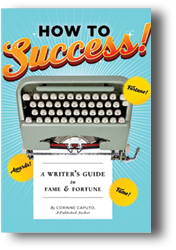 Yes, I admit it. I have a dream of becoming a famous writer. Well, the dream is more about this one book that I would like to become published and a sensational bestseller. If only there wasn’t this tiny hurdle of sitting down and writing the book in the first place. Luckily, an incredible number of guidebooks for aspiring writers tell you just that. And again, I must admit, I have purchased one or the other useful and not so helpful self-help books. Quite often, these books are full of clichés and commonsense tips that don’t tell you anything new.
Yes, I admit it. I have a dream of becoming a famous writer. Well, the dream is more about this one book that I would like to become published and a sensational bestseller. If only there wasn’t this tiny hurdle of sitting down and writing the book in the first place. Luckily, an incredible number of guidebooks for aspiring writers tell you just that. And again, I must admit, I have purchased one or the other useful and not so helpful self-help books. Quite often, these books are full of clichés and commonsense tips that don’t tell you anything new.
Enter Corinne Caputo, comedy writer. Her self-help parody book, How to Success! A Writer’s Guide to Fame & Fortune, touches a nerve. With much humor, which is blunt and of the more-is-more kind, Caputo’s first book makes fun of all the very predictable and perhaps not so helpful advice you find on the book market.
My favorite elements of How to Success! are the illustrations, starting right with the first one: Figure 1 is called “Success” and shows a sheet of paper in a typewriter where—you guessed it—the word “SUCCESS” is printed in big letters (p. 14). This is the kind of style you can expect. For fans of subtle irony, this book is probably not for you. In a chapter called “The Elements of Style: Fashion Tips,” you can find the following valuable recommendation: “Writers should generally look like they are wearing yesterday’s clothes….You can accomplish this by waking up late and wearing yesterday’s clothes” (p. 20). Awesome, isn’t it?
In the “How to Set a Scene” chapter, you find “SOME BLANK PAGES” (four pages altogether). Why? To help you create the appearance of productive writing: “Tear out and crumple the following blank pages and place them in your work space…For more blank pages, buy additional copies of this book” (p. 33). Brilliant advice, just what I like.
The slim book not only covers tips for becoming a writer, but addresses also what inevitably comes with success: enormous fame. In the “Preparing for Fame” chapter, you find information on topics such as “Developing your Autograph” or “Dealing with Fans,” where you are, for example, told to “Politely ask, ‘May I offer you my autograph’ or ‘You want to take a picture with me, don’t you?’” (p. 107).
How to Success! is a quick read and made me chuckle. Buy this book if you need to remove the odd writer’s block or just some easy and enjoyable read.
Karina Lehrner-Mayer
Karina Lehrner-Mayer is a Senior STC member, holds a degree in translation and has over 15 years’ experience in technical communication. She works as a technical writer at ISIS Papyrus Europe AG, an Austrian-based company offering solutions for inbound and outbound business communication and process management.
Teaching Interculturally: A Framework for Integrating Disciplinary Knowledge and Intercultural Development
Amy Lee, with Robert Poch, Mary Katherine O’Brien, and Catherine Solheim. 2017. Sterling, VA: Stylus Publishing. [ISBN 978-1-62036-380-5. 140 pages, including index. USD$27.50 (softcover).]
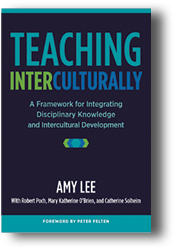 According to the timely new book, Teaching Interculturally: A Framework for Integrating Disciplinary Knowledge and Intercultural Development, we cannot ignore the increasing cultural diversity of our students. This is true even in technical and scientific courses: “…you are teaching in and experiencing intercultural classrooms regardless of whether you want to, whether you are aware of it, and whether you think it is your responsibility or relevant to your discipline” (p. 15). In other words, this is not a book that asks, “Is culture affecting my readers or users?” Instead, it goes further: “How do I design and communicate effectively in this intercultural environment?”
According to the timely new book, Teaching Interculturally: A Framework for Integrating Disciplinary Knowledge and Intercultural Development, we cannot ignore the increasing cultural diversity of our students. This is true even in technical and scientific courses: “…you are teaching in and experiencing intercultural classrooms regardless of whether you want to, whether you are aware of it, and whether you think it is your responsibility or relevant to your discipline” (p. 15). In other words, this is not a book that asks, “Is culture affecting my readers or users?” Instead, it goes further: “How do I design and communicate effectively in this intercultural environment?”
This is a tough question, and in a refreshing nod to practicality, the authors set out a developmental process instead of a “to do” list. According to them, putting the theory of “intercultural pedagogy” into practice requires time, dialog with others, cultural humility, and critical reflection. This all requires conscious effort that comes about through an iterative series of failures, reframing issues, repeated observations, and refinement.
Helpfully, Teaching Interculturally contains reflection questions throughout, such as these from Chapter 2: “Do I have habitual ways of thinking that [I] may be unconsciously ‘agreeing’ with or perpetuating inequities?” and “Where am I ‘stuck’ in habitual ways of thinking that get in the way of creating an inclusive environment?” (p. 20).
These critical thinking questions are helpfully explored by extensive case studies, written by teachers who tried to answer them. In Chapter 3, two co-authors reflect on formative cultural experiences, including a funny example of a woman who encounters strong feelings of entitlement about a pillow in her shared apartment. As she becomes “consciously present and aware” of her own response (p. 33), she realizes her unspoken assumptions about personal property. Then she crafts a more skillful response to the situation.
Two more informative case studies are in Chapters 4 and 5. In one, a history teacher creates “history problems” for his students, and in the other, a family studies teacher has her students create video ethnographies, so they avoid over-simplifying other cultures. Both examples show improvements in course design that bring student voices and cultures into the classroom. They also show how critical reflection can drive course revision.
The last chapter packs a punch, as it focuses on “productive discomfort” in the classroom. Teaching Interculturally was finalized right after the 2016 national election, which provided several examples of increased cultural tensions in the classroom. In one, a Muslim student encounters an ex-military student in an online forum, and in the other, a class learns to distinguish “racism” from “prejudice” when hate speech graffiti appears on campus.
These examples, along with the well-designed theoretical framework, help the book make a good argument for teaching interculturally.
Jake Ashcraft
Jake Ashcraft is an STC member and a chemistry professor at South Seattle College. He has worked for more than 15 years as a writer, manager, and educator in the scientific sector, focusing on scientific communication. Jake has an MS in Technical Communication from the University of Washington.
Information Design: Research and Practice
Alison Black, Paul Luna, Ole Lund, and Sue Walker, ed. 2017. New York, NY: Routledge. [ISBN 978-0-415-78632-4. 750 pages, including index. USD$79.95 (softcover).]
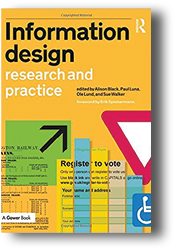 Information Design: Research and Practice presents a variety of perspectives on information design, including historical, theoretical, cognitive, and practical perspectives. The editors define information design in their introduction as a discipline devoted to making “complex information clear with the needs of users in mind” (p. xi). They then present 49 different chapters by 55 authors on topics ranging from “Icons as carriers of information” to “Medical information design and its legislation.” Each chapter delves deeply into its focused topic and provides clear illustrations of associated principles and practices.
Information Design: Research and Practice presents a variety of perspectives on information design, including historical, theoretical, cognitive, and practical perspectives. The editors define information design in their introduction as a discipline devoted to making “complex information clear with the needs of users in mind” (p. xi). They then present 49 different chapters by 55 authors on topics ranging from “Icons as carriers of information” to “Medical information design and its legislation.” Each chapter delves deeply into its focused topic and provides clear illustrations of associated principles and practices.
The collection is an exhaustive encyclopedia of information design, with much to offer a diverse array of audiences. For academic information design researchers, there are a variety of frameworks that could scaffold research into a variety of topics, from medical communication (p. 715) to science communication (p. 291). There are also 19 chapters on practical information design applications, making this a well-positioned book for use in graduate seminars, though it might be a bit weighty (literally) for the undergraduate classroom.
For technical communicators working in industry, Information Design provides many best practices that can help them do everything from understanding the psychology and history behind graphical illustrations (p. 56) to measuring the improvement of communication within an organization (p. 624). The book would probably be best used as a general reference guide for practitioners, as the scope of the book is a bit broad for project-specific issues, such as how to perform a content audit or how to create a controlled vocabulary for an information architecture.
The book at times might not be that useful to academics or practitioners looking to solve specific problems in their research, teaching, or project-based lives. As occurs with many edited collections, the scope of Information Design is so broad that it might be alienating to experienced practitioners looking for assistance with specific problems. The book reads much more like an introductory text to many of the issues, obstacles, and best practices associated with information design. Each of the book’s chapters could easily be their own book.
Overall, most readers interested in information design should find something valuable within Information Design, whether that be as a general reference, a teaching guide, or a research guide. Practitioners looking for specific solutions to project-driven problems will probably need to look elsewhere.
Guiseppe Getto
Guiseppe Getto is a faculty member at East Carolina University. He is also President and Co-Founder of Content Garden, Inc., a digital marketing and UX consulting firm.
The Zen of Social Media Marketing: An Easier Way to Build Credibility, Generate Buzz, and Increase Revenue
Shama Hyder. 2016. 4th ed. Dallas, TX: BenBella Books. [ISBN 978-1-942952-06-0. 260 pages, including index. USD$16.95 (softcover).]
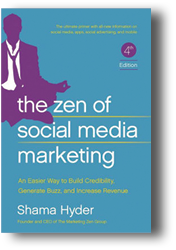 The Zen of Social Media Marketing: An Easier Way to Build Credibility, Generate Buzz, and Increase Revenue has a very simple premise. Hyder says it is “about understanding the mind-set of people who are using social media and then using it to your advantage” (p. xii). She claims that a paradigm shift has happened within marketing that requires an attendant shift in the way marketers communicate with audiences. Hyder thus defines online marketing as “the art and science (dare I say the Zen?) of leveraging the internet to get your message across so that you can move people to take action” (p. 2). She then proceeds to walk the reader through the main elements of successful social media marketing, including how to attract traffic, how to convert that traffic into customers, and how to transform their social media efforts into long-term, sustainable business development.
The Zen of Social Media Marketing: An Easier Way to Build Credibility, Generate Buzz, and Increase Revenue has a very simple premise. Hyder says it is “about understanding the mind-set of people who are using social media and then using it to your advantage” (p. xii). She claims that a paradigm shift has happened within marketing that requires an attendant shift in the way marketers communicate with audiences. Hyder thus defines online marketing as “the art and science (dare I say the Zen?) of leveraging the internet to get your message across so that you can move people to take action” (p. 2). She then proceeds to walk the reader through the main elements of successful social media marketing, including how to attract traffic, how to convert that traffic into customers, and how to transform their social media efforts into long-term, sustainable business development.
Topics covered include optimizing Web sites for marketing; content marketing; Search Engine Optimization (SEO); social media marketing; developing a brand identity over social media; marketing over Facebook, Twitter, and LinkedIn; assessing future social media platforms; social advertising; using video for marketing; and crafting a social media policy. Each chapter provides best practices, tips, and techniques for doing digital marketing, including checklists of do’s and don’ts.
This book is largely an introductory text that is probably ideal for readers new to digital marketing. It does contain good advice that advanced practitioners of digital marketing might find useful, including brief case studies of successful campaigns and research findings from the world’s top digital marketing firms. The book has clearly been updated sufficiently to still be relevant for current best practices, though the speed at which social media changes is always a challenge for any book professing to provide up-to-the-minute advice.
The Zen of Social Media Marketing is the prototypical book for practitioners as it contains best practices gleaned from a practitioner who has used the best practices she presents to build a successful digital marketing company. Hyder does carefully point out that digital marketing is a lot of work and that there is no guarantee of success. The book’s tone seems to indicate that she is genuinely interested in sharing best practices with anyone looking to improve their social media marketing skills.
Data-driven researchers and practitioners will probably find this book to be light on the kinds of information those readers are accustomed to seeing. Most of the book’s examples appear to be selected ad hoc and are not meant to generalize in any way, shape, or form. Readers interested in picking up useful skills in social media marketing will find much to like about this book. Readers looking for systematic case studies or other types of research should look elsewhere.
Guiseppe Getto
Guiseppe Getto is a faculty member at East Carolina University. He is also President and Co-Founder of Content Garden, Inc., a digital marketing and UX consulting firm.
Digital Marketing for Dummies
Ryan Deiss and Russ Henneberry. 2017. Hoboken, NJ: John Wiley & Sons. 334 pages, including index. [ISBN 978-1-119-23559-0. USD$29.99 (softcover).]
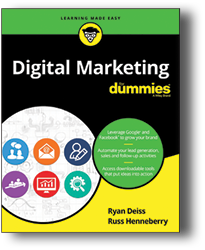 Leverage Google and Facebook to grow your brand. Automate your lead generation. Generate free and organic traffic. Acquire new leads and customers. Buy online ads like a pro. Monetize your email list. Craft landing pages that convert.
Leverage Google and Facebook to grow your brand. Automate your lead generation. Generate free and organic traffic. Acquire new leads and customers. Buy online ads like a pro. Monetize your email list. Craft landing pages that convert.
That is quite a list and some of the important topics covered in Digital Marketing for Dummies.
Let’s look first at how Deiss and Henneberry approach capturing traffic with search marketing. They look at all channels that they feel apply, including Google, YouTube, Pinterest, Amazon, and iTunes.
The authors assume and state their audience is not overly technical. They state that “to succeed in the marketing field, you need to understand marketing, not code. Feel free to leave the technical side to someone who understands code, not marketing” (p. 2).
This appears to be a valid audience and assumption for the content covered. You can also get something out of this book if you are helping someone with a campaign. The help can be in writing effective emails, case study reports, white papers, blog posts, and other assignments we are asked to complete.
Concerning writing blog posts, the authors present 57 blog post ideas; that’s a lot. The ideas include posts with lists, case studies, how to’s, frequently asked questions, series, definitions, research, checklists, interviews, guides, studies, news, parodies, cartoons, and holiday related information. The list could be useful to those of us looking for blog post ideas.
That is not all that is useful in Digital Marketing for Dummies. Can you believe there is even a section on overcoming writer’s block? I’m positively impressed with the scope of topics, writing style, and knowledge of the authors.
Jeanette Evans
Jeanette Evans holds an MS in technical communication management from Mercer. She worked with groups such as Philips Medical and Cuyahoga Community College, doing technical writing and supporting courseware development. Jeanette currently co-authors an Intercom column on emerging technologies in education and writes on other topics such as project management.
Leading Business Change: A Practical Guide for Transforming Your Organization
Karin Stumpf. 2015. Boca Raton, FL: CRC Press. [ISBN 978-1-4987-2657-3. 130 pages, including index. USD$39.95.]
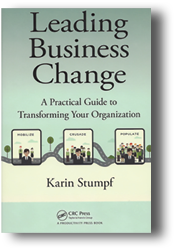 Leading Business Change: A Practical Guide for Transforming Your Organization is a reliable resource for anyone leading a team through change. The information is familiar for those experienced in change management. For new practitioners, following the guidance Stumpf shares serves as a useful roadmap.
Leading Business Change: A Practical Guide for Transforming Your Organization is a reliable resource for anyone leading a team through change. The information is familiar for those experienced in change management. For new practitioners, following the guidance Stumpf shares serves as a useful roadmap.
There are some things that I do not like about this book: The cover. The color and graphic design repel me. I don’t know why I had such a visceral reaction. The challenge questions at the end of some sections are unnecessary and alienate an educated reader. I also found myself editing the text as I read as I found plenty of phrases I would have removed.
Stumpf clearly understands how to manage change. Most chapters begin with a segment from a fictional story that is meant to instruct. Reading these segments was too disjointed, so I read all the segments as a contiguous story. After this reading, when I re-read the segments, I found them more instructive.
Stumpf follows each segment with text that explains her phased approach to managing change. In her framework, there are three phases: Mobilize (envision the solution), crusade (design the solution), and populate (deliver the solution). Each phase consists of working through four questions. Having led teams through change, I can attest that her framework is realistic and applicable.
We need to talk about how change is hard. Stumpf points outs that we love the honeymoon phase. It’s best to move through this phase and focus on the responsibilities of being a change leader, which include modelling, motivating, mediating, shaping, and communicating.
My favorite section of the book is when she talks about the role of communication in change management: “Effective communication means getting your message across in a way that is effective for your immediate audience” (p. 25). You can read more about Stumpf’s views on change later in the book.
As Stumpf takes us through the mobilize, crusade, and populate phases, she reminds us that as leaders, we need to resist wishful thinking and “work with what we have” (p. 41). This type of pragmatic guidance is what makes Leading Business Change resonate with me. She continues to give specific guidance as she shares, “Aim for about 10% of the affected people to be aware of the initiative and support your efforts before you even begin to implement the solution” (p. 69) and “Instead of focusing on the results, refocus on what you are taking away from the experience” (p. 119). It’s this type of guidance from Stumpf that makes me glad I cut through the textbook feel of the book and kept reading.
If I had read this book before I had taken my first team through a big change, I could have used the book as a guide. Even now, after taking multiple teams through lots of changes, I appreciate reading this material.
Angela Robertson
Angela Robertson works as a senior manager at Microsoft. She works with an amazing team of people. Her team is passionate about delivering content that is integral to the products you depend on for an intelligent cloud and enterprise. Before joining Microsoft, Angela worked at Red Hat and IBM.
Economies of Writing: Revaluations in Rhetoric and Composition
Bruce Horner, Brice Nordquist, Susan M. Ryan, eds. 2017. Logan, UT: Utah State University Press. [ISBN 978-1-60732-522-2. 308 pages, including index. US$29.95 (softcover).]
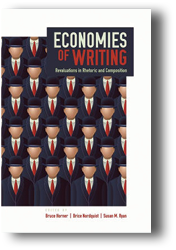 Economies of Writing: Revaluations in Rhetoric and Composition is a collection focusing on the political economies and economics of writing, writing scholarship, and writing programs. The book contains 17 selections divided into four sections each with a different focus: Institutional/Disciplinary Economies, Economies of Writing Pedagogy and Curriculum, Economies of Language and Medium, and Public Writing Economies. The editors focus on challenging the dominant capitalistic economic lens through which many examine writing, composition, and rhetoric. The economic and political theories used by many of the authors are left leaning in nature.
Economies of Writing: Revaluations in Rhetoric and Composition is a collection focusing on the political economies and economics of writing, writing scholarship, and writing programs. The book contains 17 selections divided into four sections each with a different focus: Institutional/Disciplinary Economies, Economies of Writing Pedagogy and Curriculum, Economies of Language and Medium, and Public Writing Economies. The editors focus on challenging the dominant capitalistic economic lens through which many examine writing, composition, and rhetoric. The economic and political theories used by many of the authors are left leaning in nature.
The focus in the first section is the economics of writing inherent in the academic institution. In the second section, the focus shifts slightly to focus on the economies in the curriculum, with much of the focus falling on first year and remedial instruction. The third section moves to language economy in global and online marketplaces and covers the economics of being multilingual, the commodification of writing in the knowledge economy, and the growing translingual nature. The fourth section focuses on the intersection of writing economics in the public and governmental spheres of discourse.
This collection’s writing is aimed at those either with or pursuing advanced degrees. The authors’ choice of language and that contributes to this collection may be difficult for a wider undergraduate audience as much of the content is unsuitable for those without a background in the English academia. Writing program administrators or those involved in the administrative aspects of collegiate English departments may find this of value Those teaching in these departments, from graduate students to departmental heads and administrators, will find the discussion useful.
The technical communication professional may find value in this collection, particularly those desiring more information on the economics of writing in the college classroom, those working with public policy proposals, and those interested the economics of writing and linguistics related to the Internet. Technical communication educators may find new ways of thinking about composition and rhetoric related to changing economic realities of writing programs. The professional technical communicator with limited involvement in academia, public policy, or interest on the intersection of writing, composition, and rhetoric with economic and political theory will find little of value here.
Christopher Matthys
Christopher Matthys is graduate student at the University of Alabama in Huntsville studying technical communications. His undergraduate degree is in political science and philosophy. Christopher also writes about different subjects on his website variousinterests.net.

